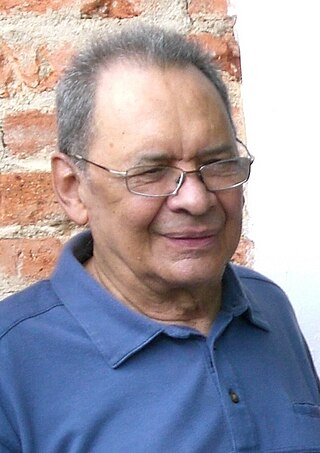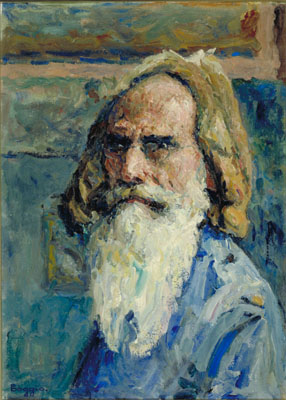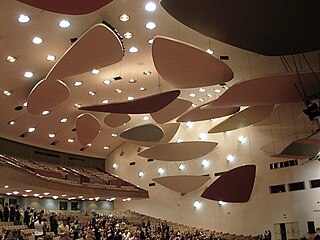
Oscar Ribeiro de Almeida Niemeyer Soares Filho, known as Oscar Niemeyer, was a Brazilian architect considered to be one of the key figures in the development of modern architecture. Niemeyer was best known for his design of civic buildings for Brasília, a planned city that became Brazil's capital in 1960, as well as his collaboration with other architects on the headquarters of the United Nations in New York. His exploration of the aesthetic possibilities of reinforced concrete was highly influential in the late 20th and early 21st centuries.

Caracas, officially Santiago de León de Caracas, abbreviated as CCS, is the capital and largest city of Venezuela, and the center of the Metropolitan Region of Caracas. Caracas is located along the Guaire River in the northern part of the country, within the Caracas Valley of the Venezuelan coastal mountain range. The valley is close to the Caribbean Sea, separated from the coast by a steep 2,200-meter-high (7,200 ft) mountain range, Cerro El Ávila; to the south there are more hills and mountains. The Metropolitan Region of Caracas has an estimated population of almost 5 million inhabitants.

Roberto Burle Marx was a Brazilian landscape architect whose designs of parks and gardens made him world-famous. He is accredited with having introduced modernist landscape architecture to Brazil. He was known as a modern nature artist and a public urban space designer. His work had a great influence on tropical garden design in the 20th century. Water gardens were a popular theme in his work. He was deftly able to transfer traditional artistic expressions such as graphic design, tapestry and folk art into his landscape designs. He also designed fabrics, jewellery and stage sets.

The Central University of Venezuela is a public university of Venezuela located in Caracas. It is widely held to be the highest ranking institution in the country, and it also ranks 18th in Latin America. Founded in 1721, it is the oldest university in Venezuela and one of the oldest in the Western Hemisphere.

Jesús Rafael Soto was a Venezuelan op and kinetic artist, a sculptor and a painter.

Carlos Raúl Villanueva Astoul was a Venezuelan modernist architect. Villanueva went for the first time to Venezuela when he was 28 years old. He was involved in the development and modernization of Caracas, Maracay and other cities across the country. Among his works are El Silencio Redevelopment which included 7797 apartments and 207 shop premises and the Ciudad Universitaria, the main campus of the Central University of Venezuela. The Campus was declared a World Heritage Site by UNESCO in the year 2000.

The University City of Caracas, also known by the acronym CUC, is the main campus of the Central University of Venezuela (UCV), located in central Caracas, the capital of Venezuela. It was designed by the Venezuelan architect Carlos Raúl Villanueva and was declared a World Heritage Site by UNESCO in 2000. The Ciudad Universitaria de Caracas is considered a "masterpiece" of architecture and urban planning, and greatly influenced Venezuelan architecture.

Pedro León Zapata was a prominent Venezuelan artist, humorist and cartoonist.

Gertrud Louise Goldschmidt, known as Gego, was a modern Venezuelan visual artist. Gego is perhaps best known for her geometric and kinetic sculptures made in the 1960s and 1970s, which she described as "drawings without paper".
The D.O.P. Foundation is a non-profit institution with spaces and documentary archives headquartered in Paris (France), Madrid (Spain), Miami (U.S.A.) and Caracas (Venezuela) that operates as an educational and lending resource of modern and contemporary art. The Foundation is dedicated to building a collection that reflects the scope and diversity of the art of our time.
José Fructoso Vivas Vivas, also known as Fruto Vivas, was a Venezuelan architect. His best known works are the Venezuelan Pavilion in Expo Hanover 2000, Táchira Club in Caracas, Venezuela, the Holy Redeemer church in San Cristóbal, Venezuela, and the Museum of Modern Art in Caracas, Venezuela.

The Palacio Municipal de Caracas, or Consejo Municipal de Caracas, is the city hall of Caracas, Venezuela. It is located on the corner of Gradillas a Monjas opposite the Plaza Bolívar, occupying half of the plaza's southern section. The building dates from the seventeenth century but now bears the mark of Alejandro Chataing's Neoclassical additions in 1906. It was the focal point for the Constitutional Convention, and signing of the Declaration of Independence in the nineteenth century. The present building is the result of the work undertaken by the Venezuelan architect Alejandro Chataing in 1906. The west wing of the building, the Capilla de Santa Rosa de Lima, the chapel where Venezuela's independence was declared in 1811, has been fully restored and furnished with authentic period pieces. The ground floor houses the Museo Caracas, which contains works by Venezuela's most celebrated painters and many other historic artifacts. It was declared a National Historic Landmark on 16 February 1979.

Emilio Boggio was an Italian-Venezuelan pioneering impressionist painter. In 1864 he traveled to France and studied at the Lycée Michelet in Paris until 1870. In 1873, he returned to Caracas and dedicated himself to the family business. In 1877, he returned to France to join the Académie Julian where he received lessons from Jean-Paul Laurens. In 1888, obtained a Hors Concours at the Salon of the Société des Artistes Français and in 1889, was awarded a bronze medal at the Exposition Universelle in Paris.
Oscar Prieto Ortiz (1905–1983) was a Venezuelan baseball executive and promoter.

The Aula Magna is an auditorium at the Central University of Venezuela. It is located within the University City of Caracas, next to the University's main library building. The hall was designed by the Venezuelan architect Carlos Raúl Villanueva in the 1940s and built by the Danish company Christiani & Nielsen from 1952–53. It was declared a UNESCO World Heritage Site in November 2000 for being artistically and architecturally significant. The most notable feature of the hall is its acoustic 'clouds', which serve both aesthetic and practical functions. They are an element of the hall's design which contributed to the science of interior space acoustics, though the building exterior is also architecturally significant.

The UCV Clock Tower, also known by its Spanish name Torre del Reloj de la UCV, or Reloj de la UCV, is a monument made of prestressed concrete. It is by the Rectory Plaza of the Central University of Venezuela in the University City of Caracas, and was built between 1953 and 1954.

Floating Clouds is a work of art by American sculptor Alexander Calder, located in the Aula Magna of the University City of Caracas in Venezuela. The 1953 work comprises many 'cloud' panels that are renowned both artistically and acoustically. The piece is seen as "one of Calder's most truly monumental works" and the prime example of the urban-artistic theory of campus architect Carlos Raúl Villanueva.

Francisco Narváez was commissioned to create pieces for the University City of Caracas campus in 1949, initially working between 1950 and 1953, with other pieces added later. The artworks include stone and metal statues, busts, reliefs, and various material of murals. Three of the statues are made of Cumarebo stone: El Atleta, a large statue in the sports complex, and La educación and La ciencia in the medical complex. The Cumarebo stone is a favourite material of Narváez. Two sculptures of the esteemed doctor José Gregorio Hernández and President José María Vargas grace the campus grounds.

Venezuelan artist Mateo Manaure was commissioned to create pieces for the University City of Caracas.

















